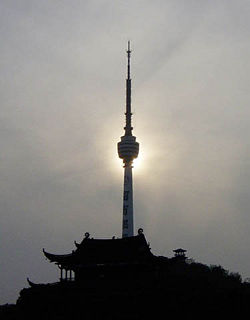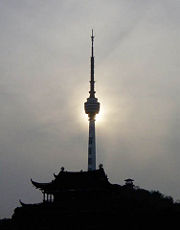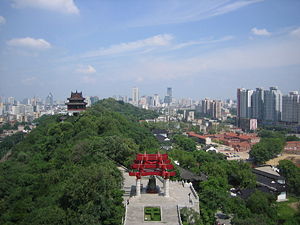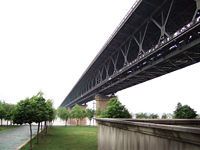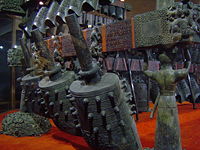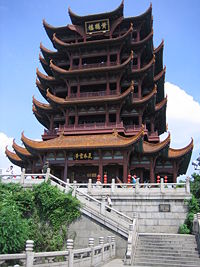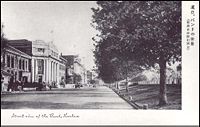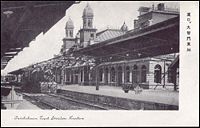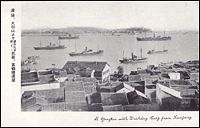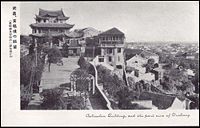Difference between revisions of "Wuhan" - New World Encyclopedia
MaedaMartha (talk | contribs) |
MaedaMartha (talk | contribs) |
||
| Line 126: | Line 126: | ||
[[Image:WuhanTVTower.jpg|180px|right|thumb|Modern and ancient]] | [[Image:WuhanTVTower.jpg|180px|right|thumb|Modern and ancient]] | ||
| − | ''' | + | |
| + | '''Wuhan''' ({{zh-stp|s=武汉|t=武漢|p=Wǔhàn}}) is the capital of [[Hubei]] province, and is the most populous city in central [[China]]. It lies at the east end of Jianghan Plain, and the intersection of the middle reaches of the [[Yangtze River|Yangtze]] and [[Han River (Hanshui)|Han River]]. Arising out of the conglomeration of three boroughs, [[Wuchang, Hubei|Wuchang]], [[Hankou]], and [[Hanyang]], Wuhan city is known as the “thoroughfare of nine provinces.” Wuhan was first opened to foreign trade in 1861, after the Second Opium War, when the British extracted rights to a foreign concession in Hankou. In 1889, the Governor-General, Zhang Zhidong, embarked on a program of industrial modernization and education which laid the groundwork for Wuchan to become a modern industrial city. In October, 1911, the Wuhan Uprising launched the revolution that overthrew the Qing Dynasty and ended imperial rule in China. In 1927, threatened by the Japanese, the Kuomintang moved the central government of the Republic of China to Wuhan. In 1938, the city was taken by the Japanese and became a major logistics center for their operations in southern China. In December 1944, the city was largely destroyed in firebombing raids conducted by the United States 14th Army Air Force. In 1967, civil strife struck the city in the [[Wuhan Incident]], as a result of tension brought on by the [[Cultural Revolution]]. | ||
| + | |||
| + | Wuhan is a major transportation hub, with dozens of railways, roads and expressways passing through the city. The opening of the First Yangtze River Bridge ([[Chang Jiang Bridge]]) in 1957 gave Wuhan speedy rail access to the rest of China. The city of Wuhan, has a population of approximately 9,100,000 people (2006), with about 6,100,000 residents in its [[metropolitan area]], and is now recognized as the political, economic, financial, cultural, educational and transportation center of central China. | ||
| + | |||
==Geography and Climate== | ==Geography and Climate== | ||
Revision as of 11:57, 25 September 2007
| Please help improve this article or section by expanding it. Further information might be found on the talk page or at requests for expansion. This article has been tagged since June 2007. |
- For the brand of cymbal, see Wuhan cymbals.
| Wǔhàn 武汉 |
|
| The Wuhan TV tower | |
| Location within China | |
| Coordinates: {{#invoke:Coordinates|coord}}{{#coordinates:29|58|20|N|113|53|29|E|type:city | |
|---|---|
| name= }} | |
| Country | People's Republic of China |
| County-level divisions | ? |
| Township divisions | ? |
| Settled | ca. ??? BC |
| Government | |
| - CPC Wuhan | Miao wei |
| - Mayor | Li xiansheng |
| Area (ranked ??th) | |
| - City | 8,467.11 km² (3,269.2 sq mi) |
| Elevation | ? m (Expression error: Unrecognized punctuation character "?". ft) |
| Population (2007 Aug) | |
| - City | 9,700,000 (4th) |
| - Density | 947/km² (2,452.7/sq mi) |
| - Urban | approx. 6.66 million |
| - Mun. Density rank | (?th) |
| - Major nationalities | Han - 99% Minorities - 1% |
| Time zone | China Standard Time (UTC+8) |
| Postal code | 430000 - ?????? |
| Area code(s) | +86/27 |
| License plate prefixes | 鄂A 鄂O (police and authorities) |
| ISO 3166-2 | cn-?? |
| GDP (2006) | CNY 259.0 billion (16th) |
| - per capita | CNY 28,688 (?nd) |
| HDI (2005) | ? (?nd) — high |
metasequoia plum blossom |
|
| Website: [1] [2] (English) | |
Wuhan (Simplified Chinese: 武汉; Traditional Chinese: 武漢; pinyin: Wǔhàn) is the capital of Hubei province, and is the most populous city in central China. It lies at the east end of Jianghan Plain, and the intersection of the middle reaches of the Yangtze and Han River. Arising out of the conglomeration of three boroughs, Wuchang, Hankou, and Hanyang, Wuhan city is known as the “thoroughfare of nine provinces.” Wuhan was first opened to foreign trade in 1861, after the Second Opium War, when the British extracted rights to a foreign concession in Hankou. In 1889, the Governor-General, Zhang Zhidong, embarked on a program of industrial modernization and education which laid the groundwork for Wuchan to become a modern industrial city. In October, 1911, the Wuhan Uprising launched the revolution that overthrew the Qing Dynasty and ended imperial rule in China. In 1927, threatened by the Japanese, the Kuomintang moved the central government of the Republic of China to Wuhan. In 1938, the city was taken by the Japanese and became a major logistics center for their operations in southern China. In December 1944, the city was largely destroyed in firebombing raids conducted by the United States 14th Army Air Force. In 1967, civil strife struck the city in the Wuhan Incident, as a result of tension brought on by the Cultural Revolution.
Wuhan is a major transportation hub, with dozens of railways, roads and expressways passing through the city. The opening of the First Yangtze River Bridge (Chang Jiang Bridge) in 1957 gave Wuhan speedy rail access to the rest of China. The city of Wuhan, has a population of approximately 9,100,000 people (2006), with about 6,100,000 residents in its metropolitan area, and is now recognized as the political, economic, financial, cultural, educational and transportation center of central China.
Contents
Geography and Climate
Wuhan is situated in the middle of Hubei Province of China, East Longitude 113°41′-115°05′, North Latitude 29°58′-31°22′.the east of Jianghan Plain, and the confluence of the middle reaches of the Yangtze River and Hanshui River.
The metropolitan area comprises three parts - Wuchang, Hankou, and Hanyang, commonly called the "Three Towns of Wuhan" (hence the name "Wuhan," combining "Wu" from the first city and "Han" from the other two). Wuhan was established by the consolidation of these three cities in 1927. These three parts face each other across the rivers and are linked by bridges, including one of the first modern bridges in China, known as the "First Bridge." Its geological structure is simple: low and flat in the middle and hilly in the south, with the Yangtze and Han rivers winding through the city.
Wuhan occupies an area of 3279.71 sq. mi. (8494.41 sq. km.), most of which is plains, broken by hills and a great number of lakes and ponds. Wuhan has a subtropical monsoon climate with abundant rainfall and four distinct seasons. The climate is generally pleasant. In recent thirty years, the average annual rainfall has been 49.96 in. (1269 mm), mainly from June to August; annual temperature is 60.44°F – 63.5°F (15.8℃-17.5℃), annual frost free period lasts 211 to 272 days and annual sunlight duration is 1810 to 2100 hours.
History
The area around Wuhan was first settled more than 3,000 years ago. During the Han Dynasty (260 B.C.E. – 220 C.E.) , Hanyang became a fairly busy port. In the third century C.E. one of the most famous battles in Chinese history and a central event in the Romance of the Three Kingdoms — the Battle of Red Cliffs — took place in the vicinity of the cliffs near Wuhan. Around that time, walls were built to protect Hanyang (206 C.E.) and Wuchang (223 C.E.). The building of the walls around Wuchan marks the foundation of Wuhan. In 223 C.E., the Yellow Crane Tower (黄鹤楼) was constructed on the Wuchang side of the Yangtze River. Cui Hao, a celebrated poet of Tang Dynasty, visited the building in the early eighth Century; his poem made the Yellow Crane Tower the most celebrated building in southern China. The tower is considered the symbol of Wuhan, and it is estimated that up until the Tongzhi Reign of the Qing dynasty, as many as three hundred poems about the tower had been found in historical literature.[1]
- Yellow Crane Tower by Cui Hao
- The yellow crane has long since gone away,
- All that here remains is yellow crane tower.
- The yellow crane once gone does not return,
- White clouds drift slowly for a thousand years.
- The river is clear in Hanyang by the trees,
- And fragrant grass grows thick on parrot isle.
- In this dusk, I don't know where my homeland lies,
- The river's mist-covered waters bring me sorrow.
- : (Source: china.org.cn)
Wuhan has long been renowned as a center for the arts (especially poetry) and for intellectual studies. Under the Mongol (Yuan Dynasty), Wuchang was promoted to the status of provincial capital. By approximately three hundred years ago, Hankou had become one of the country's top four trading towns.
In the late 1800s railroads were extended on a north-south axis through the city, which then became an important transhipment point between rail and river traffic. At this time foreign powers extracted mercantile concessions, and the riverfront of Hankou was divided up into various foreign-controlled merchant districts containing the offices of trading firms, warehouses, and docking facilities.
In 1911, Sun Yat-sen's followers launched the Wuchang Uprising that led to the collapse of the Qing Dynasty and the establishment of the Republic of China. Wuhan was the capital of a leftist Kuomintang government led by Wang Jingwei in opposition to Chiang Kai-shek during the 1920s.
In 1938, Wuhan and its proximities became the site of the Battle of Wuhan, a major conflict in the Second Sino-Japanese War. After being taken by the Japanese in 1938, Wuhan became a major Japanese logistics center for operations in southern China. In December 1944, the city was largely destroyed in firebombing raids conducted by the United States 14th Army Air Force. In 1967, civil strife struck the city in the Wuhan Incident as a result of tension brought on by the Cultural Revolution.
The city has been subject to numerous devastating floods, which are supposed to be controlled by the ambitious Three Gorges Dam, which is set to be completed in 2009.
Significant Historical Events in Wuhan History
Opening Hankou as a Trading Port During the Second Opium War (known in the West as the Arrow War, 1856-1860), the Government of Qing Dynasty was compelled to sign Treaties of Tianjin and Convention of Peking, which stipulated eleven cities or regions including Hankou as trading ports. In December 1858, James Bruce (the 8th Earl of Elgin), the leader of the British troops, brought four warships up the Yangtze River to Wuhan to collect the intelligence needed to force the opening of Wuhan as a trading port. In the spring of 1861, Counselor Harry Parkes and Admiral Herbert were sent to Wuhan to open the trading port. Based on the Convention of Peking, Harry Parkes concluded the Hankou Lend-Lease Treaty with Guan Wen, the governor-general of Hunan and Hubei, which made an area of 11.78 square miles (30.53 square kilometers) along the Yangtze River (from Jianghan Road to Hezuo Road today) into a British Concession and permitted Britain to set up their consulate there immediately. In this manner, Hankou finally became an open trading port.
Hubei under Supervision of Zhang Zhidong In the fifteenth year of the Guangxu Period (1889) of the Qing Dynasty, Zhang Zhidong transferred from Guangdong to be the governor-general of Hunan and Hubei, and by 1906, he had supervised Hubei for 17 years. During this period, he elucidated the theory of “Chinese learning as the base, Western learning for application” in great detail. He greatly developed foreign-oriented industry, founding Hanyang Ironworks, Daye Iron Mine, Pingxiang Coal Mine and Hubei Arsenal as well as setting up a spinning office, weaving office, hemp office and filature office. Zhang also initiated educational reform, opening dozens of modern educational institutions, such as Lianghu (Hunan and Hubei) Academy of Classical Learning, Civil General Institute, Military General Institute, Foreign Languages Institute and Lianghu (Hunan and Hubei) General Normal School. He sent a large number of students for to study overseas, which gave a strong impetus to the development of modern education in China. Zhang trained modern soldiers and organized a modern army including a zhen and a xie (both zhen and xie were army units in the Qing Dynasty) in Hubei. All of these activities laid a solid foundation for the modernization of Wuhan.
Wuchang Uprising On October 10th of the third year of Xuantong Period of the Qing Dynasty (1911), an armed uprising broke out in Wuchang. Before the uprising, rebels had conducted a propaganda campaign and founded various revolutionary organizations in Wuhan to mobilize intellectuals and workers to overthrow the Manchu Qing Dynasty. Earlier, in September of 1911, the Qing Government had moved part of the new Hubei army to Sichuan to suppress a people’s uprising there, providing an opportunity for the uprising in Wuhan. On September 14th, Literature Society and gongjinhui, the two greatest revolutionary organizations in Hubei, founded a joint headquarters in Wuchang and began to plan a revolt. On the morning of October 9th, a bomb exploded accidentally at the headquarters, and during the ensuing investigation, the proclamation letter, membership roll and official seal of the rebel organizers fell into the hands of Rui Cheng, the governor-general of Hunan and Hubei. He demolished the headquarters in Wuchang that same day, and decided to use the membership lists to raid the homes of the revolutionaries.
At this critical moment, the leaders of the revolutionary organizations contacted each other secretly and decided on an immediate uprising. On the night of October 10th, the revolutionaries fired on the engineering barracks of the new army, and then convinced each barracks of the new army to join the uprising. Under the guidance of Wu Zhaolin, Cai Jimin, and other leaders, the revolutionary army seized the official residence of the governor and government offices including fan, and nie, in Hubei. Rui Cheng fled in panic to a ship, the Chu-Yu, anchored by the river, and Zhang Biao, the commander of the Qing army, also abandoned the city and fled. On the morning of October 11th, the revolutionary army took the whole city of Wuchang. However, Jiang Yiwu, Sun Wu and other leaders had disappeared, so the revolutionary army recommended Li Yuanhong, the second-in-command of the Qing army, as the commander-in-chief, founded a Hubei Military Government, and proclaimed the abolition of the imperial Qing Dynasty and the founding of Republic of China. An open telegram was published, calling for every province to join the uprising. As the beginning of the Revolution of 1911, which, led by Dr. Sun Yat-sen, overthrew the Qing Dynasty, the Wuchang Uprising played a crucial role in stimulating the upsurge of the democratic revolution. Wuhan was credited with being the “the leader in launching the Revolution of 1911” (Xinhai).
National Government Capital Moved to Wuhan In 1926, as the Northern Expedition expanded north, the center of Great Revolution shifted from the Pearl River basin to the Yangtze River basin. On November 26, the Kuomintang Central Political Committee decided to move its capital to Wuhan. In middle December, most of the KMT central executive commissioners and National Government commissioners arrived in Wuhan, and set up a temporary joint conference which performed the functions of both central party headquarters and National Government. On January 1, 1927, they decided to combine the three towns of Wuchang, Hankou, and Hanyang into Wuhan City, called “Capital District.” The National Government was located in the Nanyang Building in Hankou, while the central party headquarters and other organizations chose their locations in Hankou or Wuchang. In the earlier period after its move, the National Government approved and implemented a series of policies and resolutions which favored the local population and won their enthusiastic support for the national revolution.
The Sinking of the “Zhongshan” in Jinkou In early October of 1938, Japanese forcess moved upon the outskirts of Wuhan from the east and north. As a result, the Party and government institutions, many businesses and large numbers of people had to withdraw from Wuhan to the west of Hubei and Sichuan. The KMT navy undertook the responsibility of patrolling to defend the Yangtze River and cover the withdrawal. On October 24th, while keeping watch over the waters of the Yangtze River near Jinkou (Jiangxia District in Wuhan) in Wuchang, the famous KMT navy warship, the Zhongshan, was attacked by six Japanese planes. The planes took turns diving to strafe and bomb the Zhongshan. Though the officers and soldiers under the command of Captain Sha Shijun shot down two hostile planes, the Zhongshan warship was so damaged that it eventually sank, and twenty-five officers and soldiers lost their lives. Originally named Yongfeng, the Zhongshan, 62.1 meters long and 8.9 meters wide, with a tonnage of 836 tons and a speed of 13.5 sea miles/h., was a gunboat ordered from the Japanese Mitsubishi Shipyard in 1910 by the Qing Government. In 1913, the Yongfen, with 138 seamen, was incorporated in the first armada of Chinese navy, which then took part under the guidance of Cheng Biguang in the movement launched by Sun Yat-sen in July 1917 to defend the constitution. In June of 1922, Sun Yat-sen stayed on the Yongfeng warship for over 50 days, while commanding the suppression of a rebellion mounted by Chen Jiongming. To commemorate Sun Yat-sen, the Yongfeng was renamed Zhongshan on April 13, 1625. In 1926, the Zhongsan was used by Jiang Jieshi to repel the Communists. Because of the Zhongshan’s significant historical value, the cultural relic department of Hubei province endeavored for years to salvage it and finally succeeded in 1996, building a Zhongshan exhibition hall in Jinkou after it was repaired.
Completion and Opening of the First Yangtze River Bridge The building of the First Yangtze River Bridge (Chang Jiang Bridge) was regarded as one of the key projects of the first Five-Year Plan. The Engineering Bureau of the First Yangtze River Bridge, set up by the Ministry of Railways in April, 1953, was responsible for the design and construction of the bridge. The document “Resolutions on Building the First Yangtze River Bridge” was passed in the 203rd conference of State Council on January 15, 1954. A technical conference on possible sites for the bridge was held in Hankou on January 15, 1955, and determined that the best choice was the route from Tortoise Hill to Snake Hill. By October 25, 1955, the bridge proper was under construction. By the same day in 1957, the whole project was completed and an opening ceremony was held on October 15. The whole bridge was 5479 ft (1670m) long; the superstratum was a highway with a width of 73.8 ft (22.5m) and the substratum was a double-line railway with a width of 59 ft (18m). The bridge proper was 3793 ft (1156m), long with two pairs of eight piers and nine arches with a space of 420 ft (128m) between each arch. The First Yangtze River Bridge made the Beijing-Wuhan and Guangdong-Wuhan railways possible, and any place in China could now be reached by rail from Wuchang, Hankou or Hanyang. Wuhan was a thoroughfare to nine provinces not only in name but in reality.
Transportation
Before the Chang Jiang Bridge was built over the Yangtze River (Chang Jiang) in 1957, carrying the railroad directly across the river between Snake Hill (on the left in the picture below) and Turtle Hill, it could take an entire day to ferry railcars across on barges. The bridge, which accommodates a double-track railway on a lower deck and a four lane roadway above, was built with the assistance of advisers form the Soviet Union, it is therefore an incongruous piece of Stalinist architecture in the middle of China.

Roads, Expressways and Bridges
The second bridge, a cable-stayed bridge, built of pre-stressed concrete, has a central span of 1312 ft (400 m). The Wuhan Second Changjiang Bridge is 15,347 ft (4,678 m) in length, including 6158 ft (1,877 m) of the main bridge, and 87 – 100 ft (26.5 - 33.5 m) in width. Its main bridgeheads are each 95 ft (90 m) high, pulling 392 thick slanting cables together in the shape of double fans, so that the central span of the bridge is well poised on the piers and the bridge's stability and vibration resistance are ensured. With six lanes on the deck, the bridge is designed to handle 50,000 motor vehicles passing every day. The bridge was completed in 1995
The third bridge
The Third Wuhan Changjiang Bridge was completed in September, 2000. Located 5.3 miles (8.6 kilometers) southwest of the First Bridge, construction of Baishazhou Bridge started in 1997. With an investment of over 1.4 billion yuan (about 170 million U.S. dollars), the bridge, which is 11,765 ft (3,586 m) long and 87 ft (26.5 m) wide, has six lanes and a capacity of 50,000 vehicles per day. The bridge is expected to serve as a major passage for the future Wuhan Ring Road, enormously easing the city's traffic and aiding local economic development.
Railway
The city proper in Wuhan is served by two railway stations located in the boroughs of Hankou and Wuchang. As a result, the railway system in China actually does not have a unique designation for the name "Wuhan," and trains heading to Wuhan are marked with the respective borough's station name, not the city's. In 2006, construction began on a new Wuhan Railway Station with eleven platforms.
Public Transit
In September, 2004, Wuhan became the sixth Chinese city with a subway system (after Beijing, Tianjin, Shanghai, Guangzhou and Shenzhen). The first 6.3 mile (10.2 km) line, with ten stations, is an elevated rail (and therefore called 'light rail' in Chinese terminology). It runs from Huangpu to Zongguan in the downtown area of the Hankou District, and it is the first one in the country to use a communication-based train control system (a Moving Block signalling system, provided by Alcatel). The designed minimum interval is only 90 seconds between two trains and it features driverless operation.
Wuhan Tianhe International Airport
Opened in April of 1995, Wuhan Tianhe International Airport is one of the busiest airport in central China and it is located 15.5 mils (26km) north of Wuhan. It has also been selected as China's fourth international hub airport after Beijing Capital International, Shanghai-Pudong and Guangzhou Baiyun.
Tourist sites
- At Wuchang you can find East Lake, the largest lake within a city in China.
- The Hubei Provincial Museum includes many artifacts excavated from ancient tombs, including a magnificent and unique concert bell set (bianzhong). A dance and orchestral show is given here, using reproductions of the original instruments.
- The Rock and Bonsai Museum includes a magnificent mounted platybelodon skeleton, many unique and finely figured rocks, a giant quartz crystal (as large as an automobile) and an outdoor garden with miniature trees in the penjing ("Chinese Bonsai ") style.
- Some luxury Riverboat tours begin here after a flight from Beijing or Shanghai, with several days of flatland cruising and then climbing through the Three Gorges with passage upstream past the Gezhouba and Three Gorges dams to the city of Chongqing. With the completion of the dam a number of cruises now start from the upstream side and continue east, with tourists traveling by motor coach from Wuhan. Although there is no longer the excitement of fast water cruising through the three gorges, and some of the historic wall carvings will soon be underwater, much of the drama of the high cliffs and narrow passages remains.
- The Yellow Crane Tower (Huanghelou), modern in structure, ancient in lore and legend. The original tower is presumed to have been first built in approximately 220 C.E. The tower has been destroyed and reconstructed numerous times, was burned last, according to some sources, in 1884. Jung Chang's book 'Mao The Unknown Story', however, refers to Mao ascending the Yellow Crane Pavilion in 1927 to look across the vastness of the Yangtze, suggesting a later date for its destruction. Complete reconstruction took place in 1981. The reconstruction utilized modern materials and even includes an elevator, yet in outward appearance and detail, it is true in spirit to the traditional design of the tower through the centuries.
- Jiqing Street(吉庆街), a street full of road side restaurants and street performers during the evening, well-known by Chinese due to a novel Live Show (生活秀) with stories of events on this street by Chi Li. It's a great place to see how locals live and eat, and to enjoy some local performances. Each song costs around 10 RMB, and you can order 3 songs with 20 RMB, provided you know the song names in Chinese. Performances include pop music, folk songs, rock'n'roll, and stand-up comedy, mostly in Mandarin or local dialect.
Economy
Wuhan is a sub-provincial city. As of 2006, its GDP was RMB 259 billion and GDP per capita was approximately RMB 30,200 (US$3,790). In 2006, the city's average disposable income was 12,355 yuan.
Wuhan has currently attracted French investment in fifty companies, over one third of French investment in China, the most among Chinese cities.[2]
Wuhan has a solid economic foundation. It is an important functional center for economy, trade, finance, transportation, information and technology, and education in Central China. Its major sectors include modern manufacturing industries with optic electronic, information, and automobile manufacture as the key components; steel manufacturing, a new pharmaceutical sector; biology engineering; new material industry; and environmental protection. Wuhan Iron & Steel (Group) Co. and Dongfeng-Citroen Automobile Co., Ltd have settled in this city. [3]
Colleges and Universities
Wuhan is the scientific and educational center of Central China. There are thirty-five higher educational institutions including the well-known Wuhan University, Huazhong University of Science & Technology, three state-level development zones and many enterprise incubators. Huazhong University of Science and Technology covers all the fields of science and technology and employs the best scientists and researchers in these fields. Wuhan has formed a comprehensive scientific and educational strength ranking third in China, with three national development zones and four scientific and technologic development parks, as well as numerous enterprise incubators, over 350 research institutes, 1470 high-tech enterprises, and over 400,000 experts and technicians. There are eight national colleges and universities[3], and fourteen public colleges and universities[4] in Wuhan.
Language
Wuhan natives speak a dialect of Southwestern Mandarin Chinese. Because it also has a blend of southern Chinese elements, the Wuhan dialect was once promoted as the ideal basis for a standard Chinese dialect. Standard Chinese, however, is now based on the Beijing dialect.
Folklore
Because of its hot summer weather, Wuhan is known as one of the Four Furnaces of China, along with Nanjing, Nanchang and Chongqing. Wuhan is by far the hottest of the Four Furnaces; the average temperature in July is 37.2°C (99°F), and the maximum often exceeds 40°C (104°F).
The Lute Platform in Hanyang was where the legendary musician Yu Boya is said to have played. Yu Boya played for the last time over the grave of his friend Zhong Ziqi, then smashed his lute because the only person able to appreciate his music was dead.
Popular Foods
- Hot and Dry Noodle, "Re gan mian" (热干面) is a kind of noodle which is very popular in this city. The Chinese word "Re" means hot and "gan" means dry. It is considered to be the most representative local food for breakfast.
- Duck's Neck, "Ya Bo Zi" (鸭脖子) is a local version of this popular Chinese dish, made of duck necks and spices.
- Bean Pan, "Dou Pi" (豆皮)is a popular local dish with a soy skin containing egg, rice, beef, mushrooms and beans.
- Soup Bun, "Tang Bao"(汤包)is a kind of dumpling with thin skin made of flour, steamed with very juicy meat inside; it is called Tang(soup)Bao(bun, because every time one takes a bite from it the soup inside spills out.
- Salty Doughnut, "Mian Wo"(面窝) is a kind of doughnut with a salty taste. It's much thinner than common doughnut, and is a typical Wuhan local food.
Famous people
- Dong Bi Wu was the first judge for the highest court in the People's Republic of China. He founded the famous school Wuhan high school in 1920.
- Modern Writer Chi Li is from Wuhan.
- Tennis Players Li Na and Li Ting are from Wuhan and reside in Hankou.
- Olympic gold medal diver Fu Mingxia is from Wuhan and resided in Hankou.
- Famous table tennis player Qiao Hong is from Wuhan.
- Vice Premier and Minister of Health of China Wu Yi, is a native of Wuhan. She was ranked the 2nd Most Powerful Woman in the World by Forbes.com
- Famous actress Xu Fan is from Wuhan.
- Olympic Games medal winner diver Hailiang Xiao is from Wuhan.
- Chang-lin Tien, former Chancellor of the University of California, Berkeley (1990–97)
Astronomical phenomena
- The next total solar eclipse fully visible at Wuhan will be the Solar eclipse of 2009-Jul-22 to occur on July 22, 2009
- The last total solar eclipse fully visible at Wuhan was on September 21, 1941
Soccer
In 2005, Wuhan Football Club won the Cup of CSL (China Super League) which was the first championship that Wuhan FC had ever won since the start of Chinese professional football league in 1994.
In May, 2006, top Chinese soccer team Wuhan Huanghelou announced that they had formed a lucrative deal with top English team Bolton Wanderers which would include an exchange of both coaching and commercial methods.
Sister cities
 Arnhem, Netherlands, since June 1999
Arnhem, Netherlands, since June 1999 Bordeaux, France, since June 18, 1998
Bordeaux, France, since June 18, 1998 Cheongju, Republic of Korea, since October 29, 2000
Cheongju, Republic of Korea, since October 29, 2000 Christchurch, New Zealand, since April 4, 2006
Christchurch, New Zealand, since April 4, 2006 Duisburg, Germany, since October 8, 1982
Duisburg, Germany, since October 8, 1982 Galaţi, Romania, since August 12, 1987
Galaţi, Romania, since August 12, 1987 Győr, Hungary, since October 19, 1995
Győr, Hungary, since October 19, 1995 Khartoum, Sudan, since September 27, 1995
Khartoum, Sudan, since September 27, 1995 Kiev, Ukraine, since October 19, 1990
Kiev, Ukraine, since October 19, 1990 Manchester, United Kingdom, since September 16, 1986
Manchester, United Kingdom, since September 16, 1986 Markham, Canada, since September 12, 2006
Markham, Canada, since September 12, 2006 Ōita, Japan, since September 7, 1979
Ōita, Japan, since September 7, 1979 Pittsburgh, United States of America, since September 8, 1982
Pittsburgh, United States of America, since September 8, 1982 Sankt Pölten, Austria, since December 20, 2005
Sankt Pölten, Austria, since December 20, 2005 Porsgrunn, Norway, since June 2004
Porsgrunn, Norway, since June 2004 Adelaide, Australia, since July, 2007
Adelaide, Australia, since July, 2007
See also
- List of cities in the People's Republic of China by population
- List of current and former capitals of subnational entities of China
- Wuhan Hospital for Children's Welfare
Notes
- ↑ http://english.cri.cn/725/2005/10/12/202@24327.htm
- ↑ People's Daily Online (2005-10-25). Wuhan absorbs most French investment in China. People's Daily. Retrieved 2006-10-23.
- ↑ National Colleges and Universities (in Simple Chinese). Hubei Provincial Department of Education (2006-08-31).
- ↑ Public Colleges and Universities (in Simple Chinese). Hubei Provincial Department of Education (2006-08-31).
ReferencesISBN links support NWE through referral fees
- China. 2005. Fodor's. New York: Fodor's. ISBN:1400013267 9781400013265
- Esherick, Joseph. 2000. Remaking the Chinese city: modernity and national identity, 1900-1950. Honolulu: University of Hawaiʻi Press. ISBN:0824821483 9780824821487
- Fisher, Robert C., and Leslie Ruth Brown. 1979. Fodor's People's Republic of China. New York: D. McKay.
- Knowles, Christopher. 2005. Fodor's exploring China. Fodor's exploring guides. New York: Fodor's Travel Publications. ISBN:1400014999 : 9781400014996
- Rowe, William T. 1984. Hankow: commerce and society in a Chinese city, 1796-1889. Stanford, Calif: Stanford University Press. 0804712042 9780804712040
- Wesleyan Methodist Missionary Society. 1982. Methodist Missionary Society archives, London, [on microfiche]. Section 1. Wesleyan Methodist Missionary Society. China. Correspondence. Wuchang, 1877-1905. Zug, Switzerland: IDC.
External links
| Preceded by: Nanjing |
(wartime) Capital of China 1937 |
Succeeded by: Chongqing (wartime) |
Prefecture-level divisions of Hubei
| ||||||||
| List of Hubei County-level divisions |
| |||||||||||||||||
Coordinates: {{#invoke:Coordinates|coord}}{{#coordinates:30|34|21|N|114|16|45|E|region:CN-42_type:city(4191774) | |name= }}
Credits
New World Encyclopedia writers and editors rewrote and completed the Wikipedia article in accordance with New World Encyclopedia standards. This article abides by terms of the Creative Commons CC-by-sa 3.0 License (CC-by-sa), which may be used and disseminated with proper attribution. Credit is due under the terms of this license that can reference both the New World Encyclopedia contributors and the selfless volunteer contributors of the Wikimedia Foundation. To cite this article click here for a list of acceptable citing formats.The history of earlier contributions by wikipedians is accessible to researchers here:
The history of this article since it was imported to New World Encyclopedia:
Note: Some restrictions may apply to use of individual images which are separately licensed.
